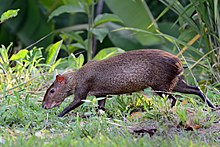| Dasyproctidae | |
|---|---|

| |
| Central American agouti, D. punctata | |
|
Scientific classification
| |
| Domain: | Eukaryota |
| Kingdom: | Animalia |
| Phylum: | Chordata |
| Class: | Mammalia |
| Order: | Rodentia |
| Superfamily: | Cavioidea |
| Family: |
Dasyproctidae Gray 1825 |
| Type genus | |
|
Dasyprocta
Illiger, 1811
| |
| Genera | |
Dasyproctidae is a family of large South American rodents, comprising the agoutis and acouchis. [1] Their fur is a reddish or dark colour above, with a paler underside. They are herbivorous, often feeding on ripe fruit that falls from trees. They live in burrows, and, like squirrels, will bury some of their food for later use. [2]
Dasyproctids exist in Central and South America, which are the tropical parts of the New World. The fossil record of this family can be traced back to the Late Oligocene ( Deseadan in the SALMA classification).
As with all rodents, members of this family have incisors, pre-molars, and molars, but no canines. The cheek teeth are hypsodont and flat-crowned.
Classification
Fossil taxa follow McKenna and Bell, [3] with modifications following Kramarz. [4]
- Family Dasyproctidae
- Genus † Alloiomys
- Genus † Australoprocta
- Genus † Branisamys
- Genus † Incamys
- Genus † Neoreomys
- Genus † Megastus
- Genus † Palmiramys
- Genus
Dasyprocta
- Azara's agouti, D. azarae
- Coiban agouti, D. coibae
- Crested agouti, D. cristata
- Black agouti, D. fuliginosa
- Orinoco agouti, D. guamara
- Kalinowski's agouti, D. kalinowskii
- Red-rumped agouti, D. leporina
- Mexican agouti, D. mexicana
- Black-rumped agouti, D. prymnolopha
- Central American agouti, D. punctata
- Ruatan Island agouti, D. ruatanica
- Genus
Myoprocta
- Green acouchi, M. pratti
- Red acouchi, M. acouchy
The pacas (genus Cuniculus) are placed by some authorities [3] [5] in Dasyproctidae, but molecular studies have demonstrated they do not form a monophyletic group. [6]
References
- ^ Woods, C.A.; Kilpatrick, C.W. (2005). "Infraorder Hystricognathi". In Wilson, D.E.; Reeder, D.M (eds.). Mammal Species of the World: A Taxonomic and Geographic Reference (3rd ed.). Johns Hopkins University Press. pp. 1538–1600. ISBN 978-0-8018-8221-0. OCLC 62265494.
- ^ Bishop, Ian (1984). Macdonald, D. (ed.). The Encyclopedia of Mammals. New York: Facts on File. p. 701. ISBN 0-87196-871-1.
- ^ a b McKenna, Malcolm C.; Bell, Susan K (1997). Classification of Mammals Above the Species Level. New York: Columbia University Press. ISBN 0-231-11013-8.
- ^ Kramarz, A. G. (2005). "A primitive cephalomyid hystricognath rodent from the early Miocene of northern Patagonia, Argentina". Acta Palaeontologica Polonica. 50 (2): 249–258.
- ^ Woods, C. A. (1993). "Hystricognathi". In Wilson, D. E.; Reeder, D. M. (eds.). Mammal Species of the World: A Taxonomic and Geographic Reference. Washington D.C.: Smithsonian Institution Press.
- ^ Rowe, D. L.; Honeycutt, R. L. (2002). "Phylogenetic relationships, ecological correlates, and molecular evolution within the Cavioidea (Mammalia, Rodentia)". Molecular Biology and Evolution. 19 (3): 263–277. doi: 10.1093/oxfordjournals.molbev.a004080. PMID 11861886.